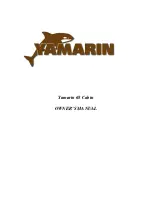
WWW.ORUKAYAK.COM 13
7. Whichever paddle you choose, you will use the same grip
and positioning for all strokes.
How to paddle
For all strokes, maintain an upright posture, with the footrest
and seat back adjusted as described on page 12.
Forward stroke
1. Start with the paddle oriented as described above.
2. Rotate to your left at the torso, and then place two-thirds
of the paddle blade in the water; imagine you’re stabbing
the water.
3. Rotate your torso toward your right with the paddle in the
water. Repeat on the opposite side, alternating strokes on
the right and left. You want to use both hands equally—
push with one hand while you pull with the other.
Reverse stroke
To stop, slow down, or move backward, do the same stroke in
reverse. There is no need to flip the paddle backward.
MANEUVERING A KAYAK
Rudder turn
1. When you have forward momentum, place your paddle in
the water just behind your hip.
2. The resistance and torsion will cause your boat to rotate
around the side the paddle is on.
Sweep-stroke turn
1. Place the paddle in the water near the bow (front).
2. Make a large arc-shaped motion toward the stern (back).
The sweep stroke can be done in a forward or reverse manner.
To turn the boat in a circle, do a forward sweep stroke on one
side and a reverse sweep stroke on the other side.
WARNING
Always practice new strokes in calm, shallow water.
WARNING
Kayakers, especially beginners and novices, can be particularly
vulnerable to adverse weather and water conditions.
Because of their light weight and limited speed,
kayaks can be especially sensitive to wind, waves, and current.
Always be aware of your paddling abilities, the water/weather
conditions, and the limitations of your kayak, and
use common sense and good judgment for your own safety.


































